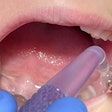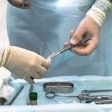
Researchers at the University of California, Los Angeles (UCLA) have advanced a surgical technique that is performed with the help of a robot to access previously unreachable areas of the head and neck, according to a new report in the journal Head & Neck (November 15, 2014).
 Abie Mendelsohn, MD, director of head and neck robotic surgery, UCLA. Image courtesy of UCLA Jonsson Comprehensive Cancer Center.
Abie Mendelsohn, MD, director of head and neck robotic surgery, UCLA. Image courtesy of UCLA Jonsson Comprehensive Cancer Center."This is a revolutionary new approach that uses highly advanced technology to reach the deepest areas of the head and neck," author Dr. Mendelsohn said in a UCLA statement. "Patients can now be treated in a manner equivalent to that of a straightforward dental procedure and go back to leading normal, healthy lives in a matter of days with few or even no side effects."
Trans oral robotic surgery (TORS), which was approved by the U.S. Food and Drug Administration in 2009, uses the da Vinci robotic surgical system by Intuitive Surgical. TORS is a minimally invasive procedure in which a surgical robot under the control of a specially trained physician operates with a three-dimensional, high-definition video camera and robotic arms.
This method can now be used to safely and efficiently remove tumors previously thought to be inoperable. It can also be used in cases that necessitated the use of highly invasive surgical techniques in combination with chemotherapy or radiation therapy.
The new approach offers patients who had little or no hope of living cancer-free lives a possible treatment plan, the study authors concluded. The technique was developed by Abie Mendelsohn, MD, at the UCLA Jonsson Comprehensive Cancer Center, and he has done more than 100 surgeries using the TORS technique. Dr. Mendelsohn is also director of head and neck robotic surgery at UCLA.
A new approach to saving lives
Current surgical techniques to reach the deepest areas of the head and neck can require external incisions to the patient's neck or the splitting of their jawbone or areas close to the voice box. Chemotherapy and radiation therapy also are often required, further complicating recovery and potentially putting patients at risk for serious or even lethal side effects.
The surgeon, working from an operating console close to the patient, operates miniature robotic "arms" that can navigate through the small, tight, and delicate areas of the mouth without the need for external incisions. A retraction system allows the surgeon to see the entire surgical area at once.
Currently, this procedure is mostly focused on patients with tumors located in the throat near the tonsils and tongue. Dr. Mendelsohn and colleagues hope to expand the scope and impact of the system in the future.
"We are tremendously excited about the possibilities for the surgical community with this new advancement of TORS," Dr. Mendelsohn said. "Now patients have options they never had before, and we can even develop potential applications for the procedure beyond the surface of the head and neck."



















